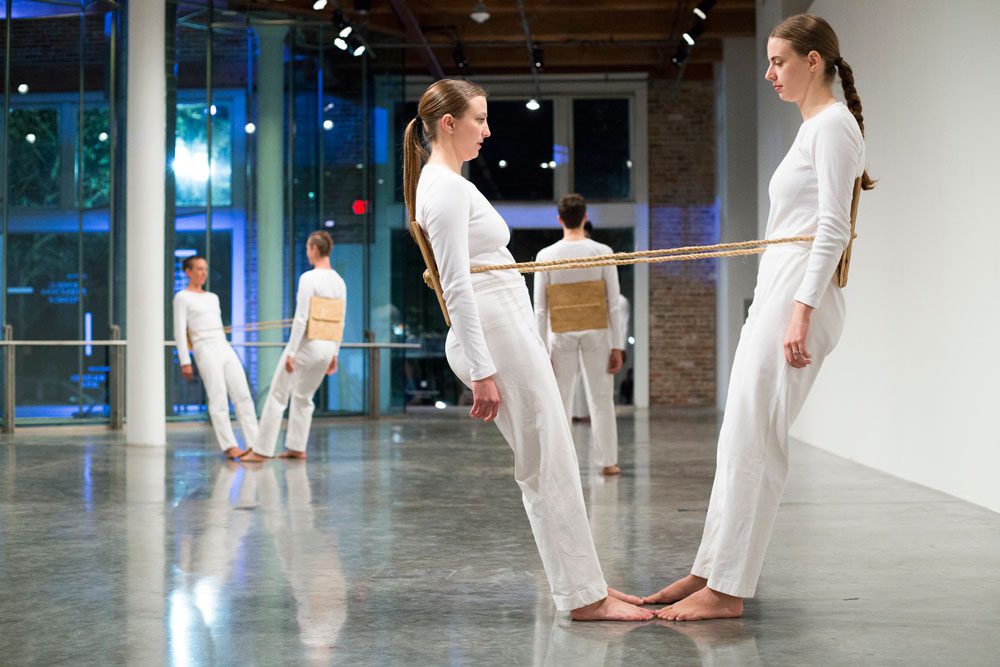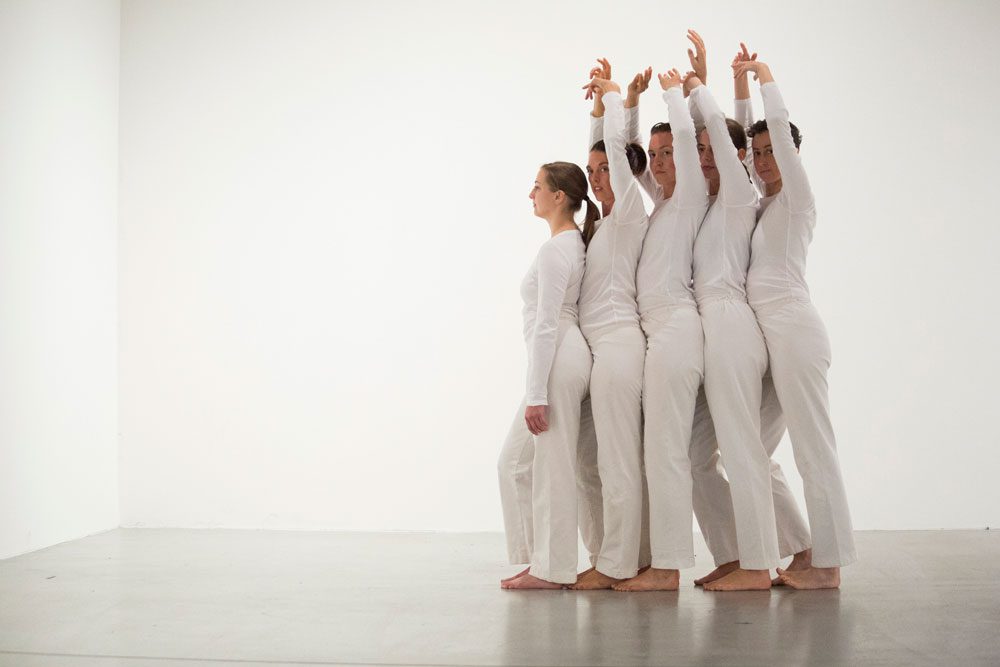Body Talk: Trisha Brown Dance Company at the Contemporary Arts Center
Charlie Tatum considers how a recent performance at the Contemporary Arts Center celebrated the legacy of dancer and choreographer Trisha Brown.

Trisha Brown Dance Company performing Leaning Duets, 1970, at the Contemporary Arts Center, New Orleans. Photo by James Morgan Owens.
Eight dancers dressed in all white stand in a single-file line, shortest to tallest, their arms curved to create broken semicircles above their heads. The sound of a metronome instructs the gentle swaying of the dancers’ hands and arms left and right, alternately tapping their heads before falling back in the other direction. The constant ticking is at once meditative and anxiety-inducing, the reliable strokes balanced by the drama of a time bomb—the audience not knowing what to expect when the clicking does indeed stop. Though spaced feet apart, the performers in choreographer Trisha Brown’s Figure 8, 1974, move in sync, connected by something unseen, equal parts mundane, magical, and menacing.
“In Plain Site,” a new program organized by New York’s Trisha Brown Dance Company, comprises a selection of the late dancer’s works from the 1970s to the 2010s, offering a sweeping overview of Brown’s career and her commitment to challenging the forms and conventions of modern dance. Last month at the Contemporary Arts Center, Brown’s company presented ten dances throughout the first floor of the museum, leading the audience from the atrium to the galleries and theater spaces. By moving the performances beyond a seated theater, “In Plain Site” highlights Brown’s push to consider everyday, non-technical motions—stomping, swinging one’s arms, falling down—as something beautiful and serious in their own right.
In the 1960s and ’70s, Brown became known for staging performances that challenged what and where dance could be. At the CAC, Accumulation, 1971, brought four dancers to the balconies overlooking the museum atrium. Throughout the five-minute performance, the four dancers added new gestures into a repeating pattern, transforming a simple movement into a longer sequence of twists and swishes. In historic compositions Man Walking Down the Side of a Building, 1970, and Walking on the Wall, 1971—not performed in New Orleans—Brown used ropes to suspend dancers whose movements appear to defy gravity. Other works incorporate the systems and structures of Conceptual Art. The three dancers in Locus Trio, 1975, rely on taped guidelines on stage to shift, rotate, and repeat collections of movement, calling to mind Sol Lewitt’s instructional drawings, which use grids to allow anyone to recreate or complete the artwork within the artist’s orderly constraints. At the CAC, this took place in the small, black-box-like Freeport-McMoRan Theater with the audience casually gathered on all sides.

Trisha Brown Dance Company performing Spanish Dance, 1973, at the Contemporary Arts Center, New Orleans. Photo by James Morgan Owens.
Moving through the museum, “In Plain Site” calls attention to the relationship between bodies and the space around them, adapting works to the particularities of the CAC’s architecture. In Scallops, 1973, a line of dancers traveled in arcs like a compass drawing along the first-floor gallery, the formation breaking apart when interrupted by corners, windows, and other obstructions. Other works emphasize the space between bodies. Leaning Duets, 1970, asks pairs of dancers to step inside contraptions made of rope and wooden boards and to lean back to balance each other’s weight in a sort of tandem trust fall. Bodyweight also plays an important role in Leaning Duets II, 1971, in which dancers standing directly side by side form walking triangles by holding their partners’ extended arms. These compositions incorporate mistakes and encourage laughter, as the dancers themselves struggle to keep straight faces throughout their wobbly journeys across the gallery, sometimes ending up on the ground.
Dressed in coordinating monochrome shirt-pant combos throughout the entirety of “In Plain Site,” the performers appear genderless, but not devoid of sexuality, notable since the conventions of ballet and dance have historically relied on the strict fulfillment of gendered roles. (For example, in a traditional dance lift, a male dancer would be expected to support a female dancer, whereas in Groove and Countermove, 2000, any of the dancers might equally be thrusted into the air.) Instead of playing into the expectations of what a dancer should and shouldn’t do, Brown’s dancers create their own gestural vocabularies, records of accumulated movements, traces of experiences, and even imagined feelings.
Brown’s work gains its strength from this type of playful erotics, which relies on an ongoing shifting of power and reassessment of one’s own position in relation to others. For Spanish Dance, 1973, another single-file line of dancers stood positioned, Bob Dylan’s rendition of “Early Morning Rain” playing in the background. The backmost performer began moving, sensually shimmying forward, expressionless but with raised arms, as if emulating a proud flamenco dancer. After running into the dancer ahead, the two continued their journey attached together, until the procession nearly smashed all five of them face-first into a wall. But this outcome doesn’t feel sad or violent, instead rather funny and tender, with the knowledge that the figures will separate, reorganize, and begin relationships anew, the collision living on as only a memory of human contact.
Editor's Note
Trisha Brown Dance Company performed “In Plain Site” October 13–15, 2017, at the Contemporary Arts Center (900 Camp Street) in New Orleans.



